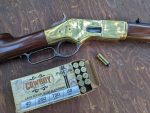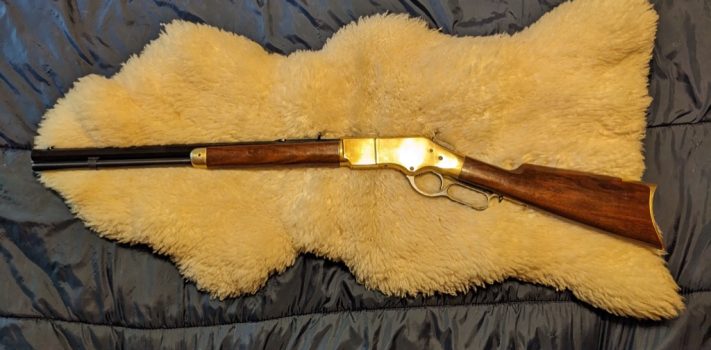Looking more like a work of art than a highly functional firearm, the Uberti 1866 Yellowboy Short Rifle in .45 Colt is an elegant combination of both art and function. With a distinctive brass receiver, a 20-inch octagonal barrel, walnut furniture, a tubular magazine capable of holding 12 rounds, and a smoothly operating lever action, the Uberti Yellowboy Short Rifle is a fitting tribute to the very first Winchester rifle, of which it is a replica. With a manufacturer-suggested retail price of $1,329 it is not the cheapest rifle on the market, but it is one of the prettiest.
Background
A little more than a year ago, I acquired a black powder Pietta M1858 .44 Remington replica from Elk Creek Company. I also acquired a Howell Arms .45 Colt conversion cylinder for the revolver. Having the option to use either black powder or .45 Colt presented a certain degree of logistic flexibility throughout the vagaries of an uncertain future.
Having a handgun chambered in .45 Colt made me think about the potential advantages of owning both a handgun and a rifle chambered for the same cartridge. So when I recently ran across the Uberti 1866 Yellowboy Short Rifle in .45 Colt, I wanted to try it out. I contacted Uberti, and they were kind enough to agree to loan me a sample for testing and evaluation. Just two days later, the rifle arrived at my local FFL’s place of business.
First Impressions
 Uberti’s media representative advised me that the rifle they were sending was a media sample, so that the finish and wood components might exhibit some minor imperfections or blemishes. I am happy to report that this was not the case. The rifle is a beautiful example of the firearms maker’s craft, with a brass receiver, beautifully finished walnut furniture, a brass butt plate, a brass foreend cap, a case-hardened lever, and an octagonal barrel and round magazine tube that are both beautifully blued.
Uberti’s media representative advised me that the rifle they were sending was a media sample, so that the finish and wood components might exhibit some minor imperfections or blemishes. I am happy to report that this was not the case. The rifle is a beautiful example of the firearms maker’s craft, with a brass receiver, beautifully finished walnut furniture, a brass butt plate, a brass foreend cap, a case-hardened lever, and an octagonal barrel and round magazine tube that are both beautifully blued.
The box that the rifle came in, on the other hand, displayed signs of some pretty rough treatment at the hands of UPS. The box was both battered and worn, but it had done a good job of protecting its contents.
The iron sights of the rifle appear to be designed more for quick target acquisition than for long range accuracy. The rifle is fairly heavy at 8.3 pounds, so I did not expect much recoil from the pistol caliber cartridges for which it is chambered.
The manual is one of the shortest firearm manuals I can ever remember reading, being printed on just one sheet of 11×17 inch paper, which is then folded twice to give the manual a total of just 8 pages. One half of the manual is given over to operating instructions, while the other half is dedicated to safety warnings.
The manual recommends never carrying the rifle with a cartridge in the chamber. This is excellent advice. Even if the hammer were to be safely lowered after a round was chambered, the rifle is not equipped with a transfer bar. This means that the hammer could strike the firing pin without the trigger being pulled if the rifle were dropped or if the hammer were to receive a blow in some other manner.
I was interested to note that the manual lists the magazine capacity for the short rifle as 8. Uberti’s website lists the magazine capacity for the short rifle as 10. In my testing, the magazine actually held 12 rounds. Perhaps the life of the magazine spring is extended if the magazine is not fully loaded. Or perhaps Uberti did not want the rifle to be identified as being equipped with a scary “high capacity” magazine. The original Winchester Yellowboy, by the way, had a magazine capacity of 15 rounds already, way back in 1866.
I tested the trigger pull weight of the rifle with a Pridefend Trigger Pull Gauge. A series of 5 pulls produced weights ranging from 6.19 to 7.20 pounds, with an average weight of 6.63 pounds and a mean weight of 6.49 pounds.
Mild Ammunition
The original 1866 Winchester was chambered in .44 Henry Rimfire. Since this round is no longer in production, Uberti chambered their modern replica in the ballistically similar .45 Colt.
The .45 Colt cartridge was originally loaded with 40 grains of black powder. Subsequent smokeless powder loads were able to match the pressures created by the black powder with a much smaller volume of powder. This leaves the .45 Colt cartridge case with a generous measure of extra volume. This extra capacity can be used to create loads that rival the power of the .44 Magnum, but those loads can only be safely used in firearms with relatively strong chambers such as the Ruger Blackhawk. Mild, standard, or hot .45 Colt loads can also be safely fired in firearms chambered for .454 Casull or .460 S&W Magnum.
 Hot loads are much too powerful for the Yellowboy, much less for the conversion cylinder for my M1858 .44 Remington replica. Since I needed a kinder and gentler loading, I contacted Fiocchi to see if they could provide me with some of their excellent Cowboy Action ammo in .45 Colt for use in my testing. They were kind enough to agree.
Hot loads are much too powerful for the Yellowboy, much less for the conversion cylinder for my M1858 .44 Remington replica. Since I needed a kinder and gentler loading, I contacted Fiocchi to see if they could provide me with some of their excellent Cowboy Action ammo in .45 Colt for use in my testing. They were kind enough to agree.
Home on the Range
After the Fiocchi ammo arrived, I went to the improvised range behind my pole barn. It was a beautiful evening in late summer. Golden shafts of sunlight filtered through the tree branches to the west. Temperatures were mild at 74 degrees Fahrenheit with a barely perceptible breeze from the west. The mosquitoes that had plagued my range sessions earlier in the summer were gloriously absent. There were intermittent clunks caused by acorns falling on the steel roof of the pole barn.
I set up a target stand in front of the backstop, and then set up a table 25 yards away. I placed a lead sled on the table, not because I was concerned about recoil, but because it provided a wonderfully stable shooting platform.
I loaded a single round of the Fiocchi Cowboy Action 250 grain LRNFP into the tubular magazine of the Yellowboy. A flick of the lever smoothly moved the round into the chamber. I aimed at the center target on the stand and pulled the trigger. The round struck near enough to the point of aim to make further zeroing unnecessary for the time being.
I found the comb of the Yellowboy to be a little too low for an ideal cheek weld, but with iron sights this was less of an issue than it would have been for scope work.
 I then fired a series of 3-shot groups. These groups varied from 0.8 inches to 2.11 inches in size, with an average of 1.38 inches and a mean of 1.24 inches. So from 25 yards using the Fiocchi ammo and iron sights, the rifle had an average MOA of 5.52 and a mean MOA of 4.96. Although this is not tack driver accuracy, it is an appropriate level of accuracy for a rifle chambered in .45 Colt, which has a low ballistic coefficient. It is also accurate enough to consistently hit the vitals of a deer at 100 yards, if used properly. This may be useful to anyone who lives in a state where straight-walled cartridges above a certain size are permitted in designated shotgun hunting zones.
I then fired a series of 3-shot groups. These groups varied from 0.8 inches to 2.11 inches in size, with an average of 1.38 inches and a mean of 1.24 inches. So from 25 yards using the Fiocchi ammo and iron sights, the rifle had an average MOA of 5.52 and a mean MOA of 4.96. Although this is not tack driver accuracy, it is an appropriate level of accuracy for a rifle chambered in .45 Colt, which has a low ballistic coefficient. It is also accurate enough to consistently hit the vitals of a deer at 100 yards, if used properly. This may be useful to anyone who lives in a state where straight-walled cartridges above a certain size are permitted in designated shotgun hunting zones.
Next, I fully loaded the tubular magazine, and found that it accommodated 12 rounds as mentioned above. I then fired all 12 rounds. I found the operation of the lever to be very smooth and consistent, with all of the rounds feeding well. The resulting group was 2.74 inches in size.
All in all, I found the rifle to operate well. Feeding was smooth, recoil was minimal, and accuracy was appropriate for the chambering.
Cleaning
Cleaning was routine. I used solvent patches on the bore and on the accessible metal surfaces until the patches came out clean. I then used dry patches to remove excess solvent, and finished up with the application of a thin film of CLP to the bore and the accessible metal surfaces.
Conclusions
The Uberti 1866 Yellowboy Short Rifle in .45 Colt is a beautiful firearm of historic interest that is adequately accurate within the limited effective range of the .45 Colt cartridge. Fiocchi Cowboy Action ammo in .45 Colt is a good match for the rifle. If you are looking for a nice-looking and smoothly functioning rifle chambered in .45 Colt, this one would be a good choice.
Disclaimer
Uberti was kind enough to loan me a sample of their 1866 Yellowboy Short Rifle in .45 Colt for testing and evaluation. Fiocchi was kind enough to provide me with some of their Cowboy Action ammo in .45 Colt for use in testing the Yellowboy. Ready Up Gear provided me with a Pridefend Trigger Pull Gauge. I tried not to let the kindness of any of these vendors interfere with my objectivity in this review, and believe that I have succeeded. I did not receive any other financial or other inducement to mention any vendor, product, or service in this article.










